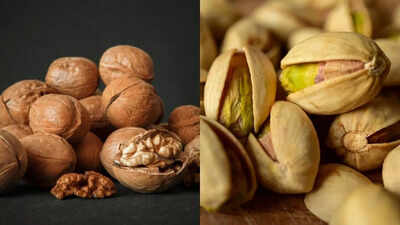Nuts are a convenient and nutritious snack, packed with flavor, satiety, and essential nutrients. When making health-conscious choices, the question often arises: Are walnuts or pistachios the superior option? Both offer a wealth of beneficial fats, protein, vitamins, and minerals, yet each possesses unique advantages.

Both walnuts and pistachios contribute significantly to health, supporting the heart, brain, digestive system, and overall well-being. While their nutritional profiles share similarities, subtle distinctions exist in their respective health benefits. Understanding these nuances can guide you in selecting the nut, or combination of nuts, that aligns best with your dietary objectives.
Here's a breakdown of the key differences between these nuts, highlighting their specific benefits:
Pistachios boast a higher protein content compared to walnuts.
Protein is crucial for muscle development and promoting a feeling of fullness. For a snack that effectively curbs hunger, pistachios are a more advantageous choice.
Walnuts stand out as the only nuts with a substantial concentration of plant-based omega-3 fatty acids, specifically alpha-linolenic acid (ALA).
Omega-3 fatty acids are vital for optimal brain function, enhancing focus, and supporting memory. Walnuts are an excellent option for students, seniors, and anyone seeking to bolster their cognitive health.
Walnuts contain heart-healthy fats that contribute to lower blood pressure and reduced inflammation.
Pistachios, on the other hand, aid in lowering "bad" LDL cholesterol levels due to their phytosterol content.
Both nuts offer cardiovascular benefits, making it advantageous to incorporate both into your regular diet.
Pistachios provide a greater amount of fiber compared to walnuts.
Fiber is essential for promoting healthy digestion, maintaining gut health, and regulating blood sugar levels. Pistachios may also foster the growth of beneficial bacteria in the gut.
Pistachios contain lutein and zeaxanthin, two potent antioxidants that safeguard the eyes and help prevent age-related macular degeneration. Walnuts offer minimal amounts of these antioxidants.
Incorporating nuts into your daily meals is simple and elevates both the flavor and nutritional value of your food. Here are some easy and delicious ways to enjoy walnuts and pistachios:
Walnuts feature a mild, subtly bitter taste and a delicate crunch, complementing both sweet and savory dishes.
Pistachios are slightly sweet, vibrantly green, and incredibly satisfying. Consuming them in the shell encourages mindful snacking and helps with portion control.
Newer articles
Older articles
 Toxic Workplace Warning Signs: Spot the Red Flags Early
Toxic Workplace Warning Signs: Spot the Red Flags Early
 Rishabh Pant Revolutionizing Cricket, Says Greg Chappell
Rishabh Pant Revolutionizing Cricket, Says Greg Chappell
 Moto G54 Price Slashed in India: Check Out the Discounted Rates and Specs
Moto G54 Price Slashed in India: Check Out the Discounted Rates and Specs
 Global Immunization Crisis: Millions of Children at Risk as Vaccine Coverage Lags, Study Reveals
Global Immunization Crisis: Millions of Children at Risk as Vaccine Coverage Lags, Study Reveals
 IRCTC Launches AI Chatbot 'AskDisha 2.0' to Revolutionize Train Ticket Booking and Customer Service
IRCTC Launches AI Chatbot 'AskDisha 2.0' to Revolutionize Train Ticket Booking and Customer Service
 Samsung Galaxy A55 vs. Vivo V30 Pro: Mid-Range Android Giants Clash in Detailed Face-Off
Samsung Galaxy A55 vs. Vivo V30 Pro: Mid-Range Android Giants Clash in Detailed Face-Off
 Smith Targets Test Return After Innovative Baseball Cage Rehab in New York
Smith Targets Test Return After Innovative Baseball Cage Rehab in New York
 Bezos-Backed Climate Satellite Declared Lost in Space After Technical Failures
Bezos-Backed Climate Satellite Declared Lost in Space After Technical Failures
 Skin Cancer Alert: How to Recognize Suspicious Moles and Early Warning Signs
Skin Cancer Alert: How to Recognize Suspicious Moles and Early Warning Signs
 20 Minutes to a Healthier Brain and Body: Neurologist's Simple Strategies to Combat Cholesterol, Blood Pressure, and Dementia
20 Minutes to a Healthier Brain and Body: Neurologist's Simple Strategies to Combat Cholesterol, Blood Pressure, and Dementia